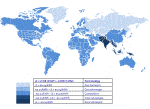The cost of unsubsidised solar power looks set to become competitive with natural gas by 2025, according to a new report from Lux Research.
In a study of 10 global regions, the report examined whether energy sourced from cheap and abundant natural gas – the forecast “golden age of gas” – would force solar to the fringes of the generation market.
However, by using a levelised cost of energy (LCOE) analysis, researchers found that by 2025, the cost of installing grid-scale solar power, without government assistance, will have fallen below the most-likely price of gas.
Utility-scale solar system costs are predicted to fall by 39 percent, meaning the LCOE from unsubsidised solar power closes the gap with electricity from combined cycle gas turbines (CCGT) to within USD $0.02/kWh worldwide in 2025.
Anti-fracking policies in Europe and prohibitive set-up costs associated with natural gas in South America will help drive down the cost of solar. The report forecasts a likely gas price of $7.60/MMBtu along with increases in module efficiency resulting in a solar power price of $1.20/Watt by 2025.
“On the macroeconomic level, a ‘golden age of gas’ can be a bridge to a renewable future as gas will replace coal until solar becomes cost competitive without subsidies,” said Ed Cahill, Lux Research Associate and the lead author of the report titled, Cheap Natural Gas: Fracturing Dreams of a Solar Future.
He says natural gas would help solve intermittency problems at large-scale solar farms and form an invaluable part of hybrid gas/solar power systems.
“Solar’s eventual cost-competitiveness means increased gas penetration actually benefits it, by enabling hybrid gas/solar technologies that can accelerate solar adoption without subsidies and increasing intermittent renewable penetration without expensive energy storage or infrastructure improvements,” the report reads.
But the transition from subsidised to unsubsidised solar won’t happen overnight, and is bound to be problematic. According to the report, standalone solar won’t be competitive before China, Japan, and the U.S. begin phasing out subsidy regimes and companies looking to invest in utility-scale projects should look at areas with scarce gas resources or develop hybrid systems that can take advantage of low gas prices.







































